
How to Start a Fitness Boot Camp Business
Boot Camp Business Plan: Everything you Need to Know
This all encompassing step-by step guide will show you how to start a fitness boot camp business from scratch.
We’ll cover everything you need to know from the qualifications you need, ideas that you can implement, tools and equipment through to how to market your boot camp business, financially forecast and scale your client base.
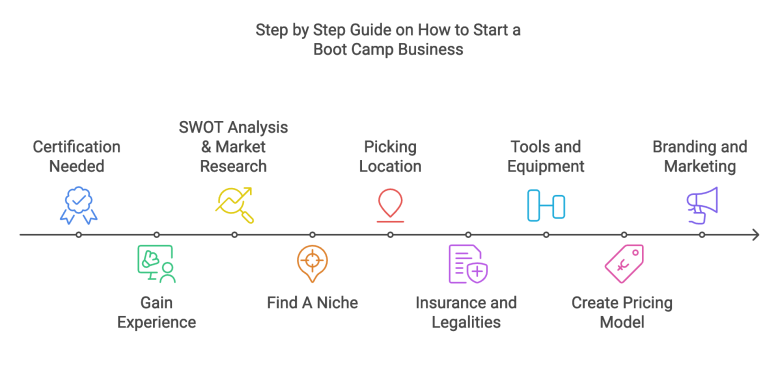
Step 1) Certification Needed to Become a Boot Camp Instructor
To become a boot camp Instructor in the UK you need to have completed a Level 2 Fitness Instructor in Gym qualification.
The Fitness Instructor qualification is the mandatory requirement to obtain insurance to become a fitness class Instructor and start offering boot camp classes.
There are two key aspects to check with qualifications before jumping on a course:
Ofqual - You need to ensure the course provider you elect to learn offers Ofqual regulated qualifications. Ofqual is the regulator of all vocational based qualifications in the UK run by the government.
CIMSPA Recognition - CIMSPA is the leading accreditor for all health and fitness based qualifications and their stamp of approval on a training provider's courses is a sign of quality. You can use CIMSPA’s endorsed training directory to check if a provider is CIMSPA endorsed.
Once you have completed your Level 2 in Fitness Instructing certificate, you can also opt to add the Fitness Boot camp CPD qualification to your arsenal, which is a short course that covers everything from how to structure a boot camp class, what workouts to include, through to how to market and promote your business.
Step 2) Gain Experience & Learn How to Run a Successful Boot Camp

You might think you know already how to run a good boot camp class or have attended lots of classes in the past, but the reality is that unless you have actually delivered a class, there is a lot you might have overlooked.
Many aspiring boot camp instructors overlook a few key skills that only practical implementation can develop:
Where to stand and positon yourself in relation to the class
How loud to talk
What to prioritise when more than once person is struggling at the same time
What if someone walks out of your class
What intensity level you should aim your class to be
Which exercises should go in which order
What if class members can't do a certain type of exercise, is there an alternative?
This is why building your experience up first is a good idea.
You can gain some general class experience by a few different means:
Shadowing Hours
You can opt to do some shadowing hours of existing boot camp or class instructors and evaluate how they execute classes.
If you offer them some help organising classes, assistance on the gym floor or taking the odd class for free, you could even get them to provide you with some constructive feedback on your own delivery that you can use to better hone your skills.
Run a Boot Camp Class for Friends and Family Members
They may not thank you for it, but offer a complimentary boot camp session to your friends and family members, who can give you some raw and honest feedback on your class delivery.
Additionally, this allows you to identify areas of weaknesses that you found to be an obstacle or proved to be more challenging than you expected.
It also allows you to build your confidence and quality of delivery, prior to starting to charge real clients.
Perform some Freelance Work First
You can find dozens of freelance group fitness instructing jobs on our jobs board from hotels, gyms, leisure centres and studios, where you can gain some valuable paid experience.
You can even ask some class attendees for their feedback on how they felt your class went.
Step 3) Perform a SWOT Analysis & Market Research for Your Fitness Boot Camp Business

As part of your fitness boot camp business plan you should perform some preliminary market research and complete a SWOT analysis to see how you can make your fitness boot camp stand out from the competition.
A Swot Analysis is just where you put strengths, weaknesses, opportunities and threats next to each of your competitors so you can devise an action plan of how you’re going to beat them.
You want to find out:
Who is operating in your area
Where they operate
Times of their classes
Who their classes target
How much class variance is there
How long have they been running the boot camps
Style of class boot camp delivery
How much they charge
What their class members get for their money
What their customers say about their classes
How do they market their boot camp business
For example, let’s say you’re looking to set-up a boot camp business in Newcastle.
You can Google “Fitness Boot Camp Classes Newcastle" and make a list of the boot camps operating in your vicinity.
You then are simply going to put what you feel is their strengths and weaknesses are into each column. This will give you inspiration for where you see opportunities or flaws you can exploit in their business structure, as well as threats they pose to you setting up your boot camp business.
There will be crossover of things that fit in two categories, such as strengths and threats as another boot camps strengths will naturally be a threat and the same applies for weaknesses and opportunities.
You can find the majority of this information online via their website or social media, but some information you can only discover by sampling their service, but I would suggest doing this as a task to gather the information you need and get a feel for how a competitor operates.
Step 4) Find A Niche(s) for your Boot Camp

When starting a fitness boot camp business, you need to consider what is going to make your boot camps different. This can include a particular demographic you wish to target, the style of boot camp delivery, the equipment you use or opting to have different themed boot camps.
See below some class ideas that you could consider:
Female Only Classes
Boot Camp obstacle course
Fitness Boot Camp for Kids
Corporate boot camp
Boot camp for seniors
Beginner Boot Camp
Military style Boot camp
Winter boot camp
Luxury Boot Camp
Partner boot camp
Post Natal Boot Camp
Boot camp for different muscle groups
Bodyweight Boot camp
Of course, you can create boot camp classes that appeal to different people and schedule them at different times on your timetable or start with one style and then add others at a later date.
Step 5) Picking Your Boot Camp Location

You need to identify where you're going to set-up your fitness boot camp and in what capacity.
Factors to consider when picking the right location when running a fitness boot camp:
Accessibility - You need your class to be easily accessible with good transport links nearby for members that don’t drive. You might also want to factor if the venue has a car park and if this car park is free for your members.
Proximity to Competitors - You might want to find a location that isn’t right next to one of your competitors, which could cause market saturation and dilute your services and profitability. Identifying a location and audience where boot camp classes are not currently being run will open the opportunity to those potential customers to join your boot camp.
Availability - When selecting a venue, you should establish if the venues availability is continuous and has the opportunity for growth. For instance if you elect to run a class from a gym or sports hall, you need to know if this availability is fixed and is not going to change if they suddenly change the times on their class timetable and that you have the
Visibility / Population Density - If you’re planning to start a boot camp training business you need to consider the value in the visibility of the venue. If it’s a town centre with high footfall, in a highly populated area or on a busy dual carriage way that adds huge value to your business’ visibility.
Cost - Venue locations really vary in cost from place to place. The cost you pay will naturally be deducted from the money you make from class members. Try and get a few quotes
There are a few common places that you can run your fitness boot camp from:
Fitness / Gym Studio
You can find gyms, studios, health clubs and Leisure Centres that rent out their studios on an hourly basis that you can use to run your boot camp business from.
See below where 3D Health clubs have a page dedicated their website for individuals to rent either of their two fitness studios:
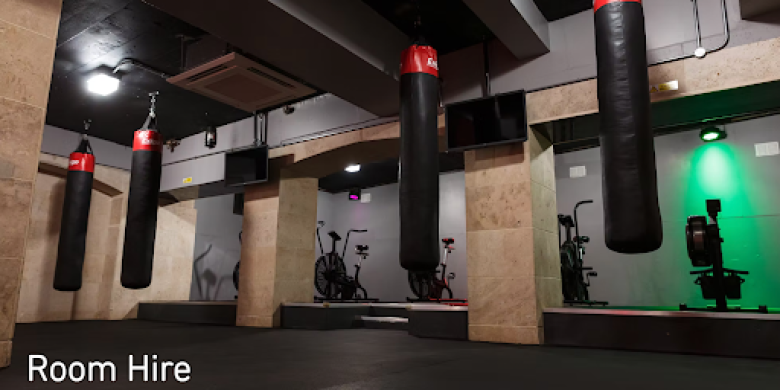
Additionally, you can approach gyms that offer classes directly about running boot camp classes from their venue outside of their standard class timetable. Gyms are always looking for extra income streams from their dead space.
Running an Outdoor Fitness Boot Camp
You can start an outdoor boot camp business where you run classes in a public space such as in a park, playground or the beach.
See an example here by One-Element who run their boot camp classes from multiple parks across the UK:
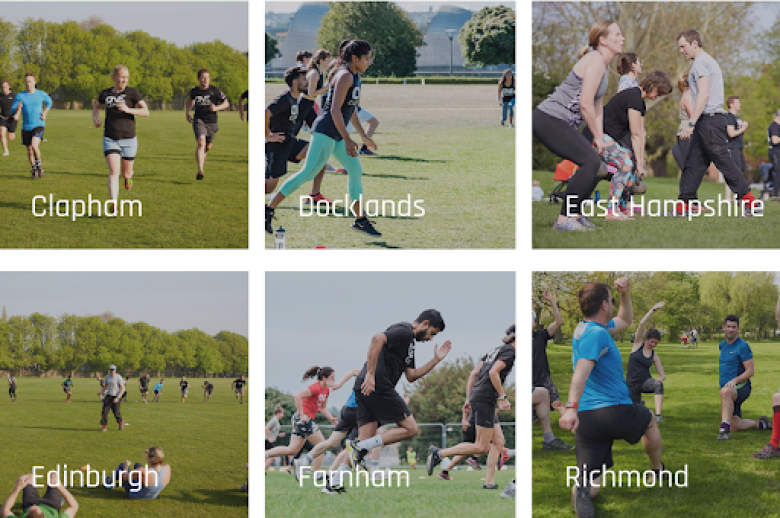
Setting up an Outdoor boot camps posses a few benefits to indoor boot camps. Firstly, some members prefer and are specifically searching for an outdoor boot camp, as they relish taking on the elements, want to take in fresh air and natural sunlight and want to escape a gym based setting.
The second major benefit is that you're not bound by any space restrictions, thus you could theoretically run multiple boot camps at the same time or even extend your class numbers to 50 people, all whilst still paying the same amount out per class and with minimal overheads.
Sports Hall, Community Centre, Local School or College
You can set-up your boot camp business from a local sports hall, which can be located at schools, colleges or community centres. These venues can be advantageous as they frequently they have large car parks, which are often free, have equipment available that you can harness with your classes, are situated within easy to access areas and your classes can run all year round as your not inhibited by unpredictable UK weather.
See here three venues I found very quickly when searching for a boot camp location in Norwich that you could use if you were planning to start a boot camp within the Norwich vicinity:

You can always combine both indoor and outdoor venue options that will provide variance to clients and allow you to target both demographics.
Step 6) Insurance, Legalities and Forms to Start a Boot Camp Business

As a fitness professional you’re going to need to ensure you’re operating within the realms of the law, legally protected yourself against any claims that could potentially arise and have all the right forms and documentation in place.
Here is a breakdown of the considerations before opening a boot camp business:
Fitness Boot camp Insurance
The first you should do after qualifying as a boot camp instructor is obtain insurance.
There are two types of fitness insurance every fitness professional needs:
Public Liability Insurance
Professional Indemnity Cover
These two insurance types cover for you when a client gets injured whilst under your supervision or if you have given bad advice that has detrimentally affected your clients wellbeing.
Additional policies that you may wish to add to your insurance plan is personal accident which covers your income if you sustain an injury and are unable to perform your duties and equipment cover, that covers your equipment costs for theft and damage.
Active Careers partners with Insure4sport, who are the UK's largest provider of personal training and sport insurance where you can obtain insurance for your boot camp business at a discounted rate.
Legalities and Forms
There are a number of legalities and forms that every boot camp Instructor needs to have covered within their business.
You need to factor any upfront legal costs into your boot camp business plan, but normally they are just a one off payment without any ongoing running costs associated to them.
Additionally, there are a number of forms that your business will need in order to operate:
Privacy Policy - All business collect and process data from individuals that enquire about class prices through to members that sign up and it is a legal requirement to have a privacy policy in place that is compliant with GDPR.
Pre-exercise questionnaire and disclaimer - A pre exercise questionnaire is essential as it can help protect you if a client incurs an injury or illness during your class. Additionally, it can help you identify before class commences if an attendee has any pre-existing medical issues that could be affect their ability to participate or be aggravated by physical activity.
Website Terms of Use / Cookie Policy - If you plan to have a website in order to market your boot camp business, you will need a website terms of use and if you're planning to track users activity on your website you will also need a cookie policy.
Client Service Agreement - A client service agreement is really useful for a boot camp Instructor as it includes all your terms of service and what happens if a class is cancelled, if a client cancels without warning, your refund policy and outlines both parties professional parameters.
Council License - If you’re planning to run a boot camp business outdoors, you will need a license and permit from your local council to operate in a park or beach. See this example guide from Solihull council where they outline the step by step process, the permit you need and your responsibilities when using a park.
If you start hiring fitness class Instructors to run classes for you, that will induce the need for far more mandatory policies as you're then becoming an employer.
Step 7) How to Run a Fitness Boot Camp: Tools, Equipment and Software

Before jumping in head first to start a fitness boot camp, you need to forecast for the types of equipment you’re going to need to be able to run the business successfully.
Here is a breakdown of software and equipment that you need to factor in when creating a fitness boot camp business:
Class Booking Software
When starting a fitness boot camp it is strongly advisable to use a fitness class booking platform to manage all your class bookings.
This will ensure that you don’t accidentally overbook any class slots, reduces you workload by allowing your customers to book classes without your assistance and allows you to track attendances.
See here how Derbyshire based Boot Camp Business “JW PT” is using an online booking platform to allow their clients to book classes online via their website:

One of the best and most popular class booking tools used by boot camp instructors is Class Fit, which comes with a 30 day trial and you can embed into your website, take payments and schedule as many boot camp classes you as like for a fixed costs
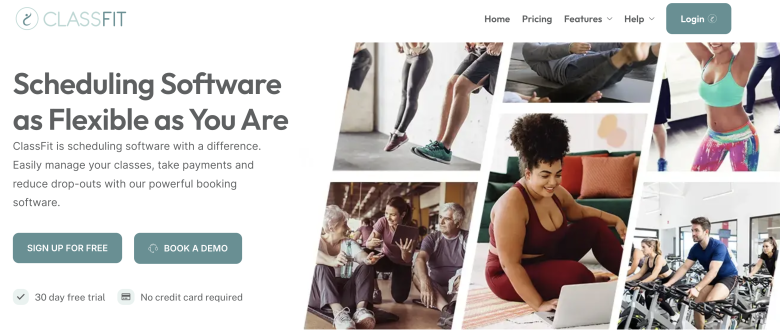
Set-up with a Payment Provider
You're going to need to take payments from your class attendees and depending on which boot camp pricing strategy you deploy (more on this later), you might need to set-up re-occurring payments to take direct debits from your class members each month.
If you’re a sole trader, you can take payment into your personal bank account and you can just set-up a PayPal account for one off payments or get your clients to set-up a standing order to you each month.
If however, you’re planning to set-up as a limited company or are planning to take direct debit payments on a regular basis, you might want to go for a company like Go Cardless which allows you to take direct debit from your members, and they just take a nominal percentage from each transaction.
Customer Relationship Platform
When your business gets up and running, you’re going to need a system to manage all your enquiries and client information, this is where a customer relationship manager (CRM) comes into play.
A CRM system allows you to store all your clients data, manage your sales, send invoices, create email automations for re-occurring tasks like onboarding or class confirmations, as well as sending out email campaigns to your database.
Accounting Software
In order to keep track of your income and expenses, it is heavily advisable to harness the power of accounting software.
Accounting tools such as quick books or free-agent are tools that link to your bank account which will track all of your income and expenses so that you don’t have to do this manually.
Boot Camp Gym Equipment

You are going to most likely need some portable gym equipment that you can transport quickly and easily, that is applicable for different ability levels and demographics.
Here is a list of boot camp equipment that you might want to purchase before starting your boot camp business:
Kettlebells
Cones
Medicine balls/ slam balls
Skipping Rope
Suspension Straps
Exercise bands
Agility ladders
Sandbags
Adjustable Dumbbells
Battle rope
Hula Hoops
If you're looking for a cost efficient way of opening your fitness boot camp business, you can source most of your equipment from places like Ebay, Facebook Market place as well as your more specific stores like Amazon and Argos.
Step 8) Create a Pricing Model & Packaging Strategy for Your Boot Camp Business
Pricing your boot camp business correctly at the start is critical to how you can scale your business moving forward and once you commit to one model, it is very challenging to re-structure your pricing plan later without losing clients.
Here are the three most common boot camp pricing models you could consider deploying:
Pay Per Class
You can adopt the pay per class pricing model where you simply charge each attendee each time they attend a class.
See below how Blackheath Boot camp offers this as an option to their clients:

Allows customers to try you first increasing uptake
Receive a high class fee per attendee
CONS
Poor client retention as they are not committed
Does not make clients commit towards long term goals
Constantly having to market to get new class attendees
Difficult to know much income your bringing in and to forecast growth
Blocked Sessions / Fixed Commitment
The blocked sessions or fixed commitment boot camp pricing strategy is where you sell boot camp classes for either a set period of time or a set number of sessions.
See an example of this being implemented here by Darlington Boot camp:
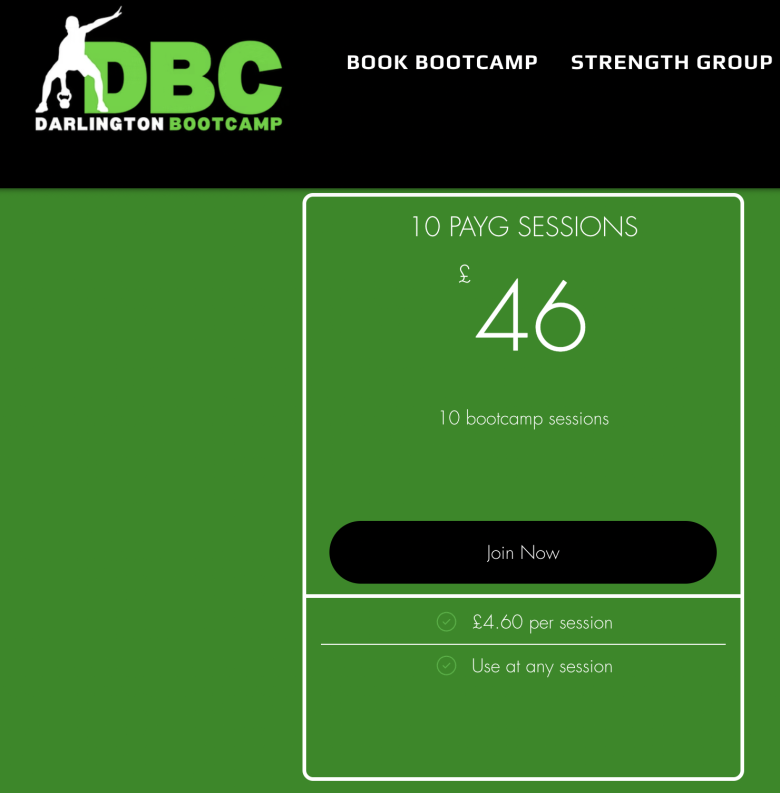
PROS
Take larger amounts upfront for your services
Get paid for sessions ahead of time
Can forecast better for growth
CONS
Need to re-sell to existing clients when sessions finish
Asking clients to pay to financially commit a lot of money in advance
Awkward conversation of having to re-ask clients for money
Clients might and often do, negotiate on price
Causes gaps in your payments
Dilutes your cost per session
Monthly Subscription Model
The monthly subscription model is where you charge attendees per month based on the number of boot camp classes they wish to commit to.
See here how Ravensourt Boot camp is deploying the monthly subscription model below where clients pay more overall for more classes per week, but it reduces the cost per session:
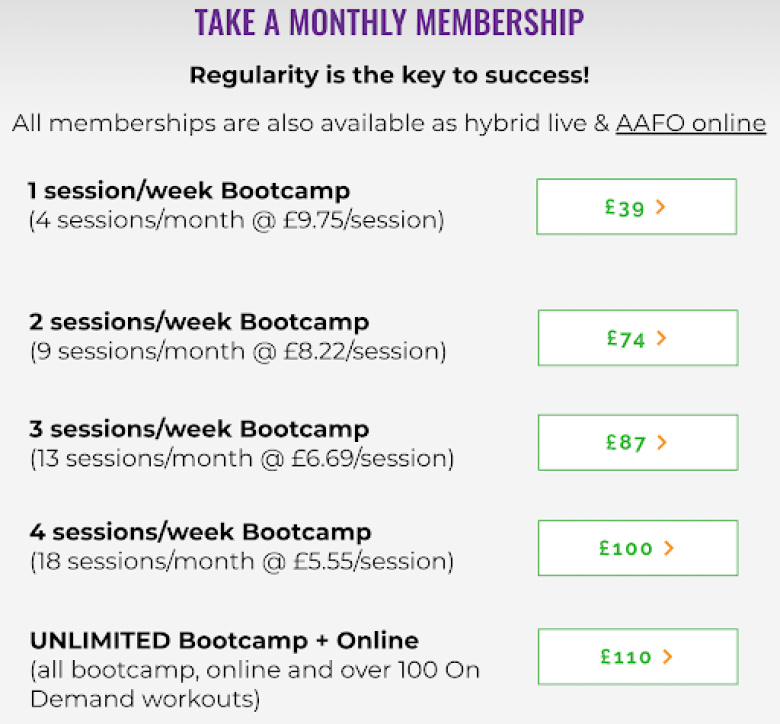
You can even add minimum term agreements to get clients to commit to a certain period of time before the contract rolls on a month to month basis, just like a mobile phone contract operates.
PROS
Gets clients committed for a long time period
Allows you to know how much income is coming into your business
You can forecast and project business growth easier
Rarely have to re-sell to the clients you have already acquired
Frees up more time to market and grow your boot camp business
Makes clients commit tom their long-term goals
Cheaper for clients and becomes a more habitual payment
CONS
Dilutes the cost of each class compared with pay as you go
Less money upfront than blocked sessions
Difficult to set-up with only a few classes on your timetable
Before you start pricing up your boot camp classes, you need to identify what makes your boot camp stand out, what extra value can your customers expect.
Only once you have decided on this can you actually put numbers to your service.
What Extra Value Are You Going to Include in Your Boot Camp Business
You need to also consider if you’re going to offer any additional services or add-ons to your boot camp packages that will add value to your clients and make you stand out from the competition.
Here are a few ideas that you can consider implementing as part of your boot camp business model:
Amenities
You might want to add value to class members by providing them with small amenities like a water bottle, a towel when they arrive for their class or a recovery drink.
Nutrition Plans
You can add value by giving all class attendees that sign up on one of your higher end packages a tailored nutrition plan to accompany their class membership.
This would add huge value to members and even help your sales as it would encourage individuals to pick your higher value service and act as an upselling tool.
Performance Rewards Scheme
Setting up a rewards scheme is a really clever way to add value to your class members and increase your class retention rates simultaneously. It shows that you care about their success and will even reward them for making a difference.
A rewards scheme works by offering prizes, incentives or financial recognition to your members hitting fitness targets. An example could be that when a member loses 3% of body fat, they get a free protein tub, 2 weeks free membership or a free branded boot camp hoodie.
You can even create tiers of prizes based on fitness goals that members can strive towards once they have completed each objective.
Body Composition Testing
You could offer your boot camp members once a month to book in for a complimentary body composition test, where you can statistically show them the difference they are making. A cost effective way to go about this is to harness a Bioelectrical Impedance Analysis (BIA) machine or use callipers.
Personalised Programme
If you are personal training qualified you can write a training programme for your clients for when they are exercising away from classes and either charge them more for this service or perhaps add it to your higher end packages to increase uptake rates.
Loyalty Programme
You can offer a loyalty programme, where clients get rewarded the longer they stay as a client with you. This differs slightly from the rewards scheme where you're rewarding performance, but instead you're going to reward effort, attendance and longevity.
This gives something back to your clients for their custom, irrespective of their results and helps you celebrate the clients that underpin your business and enables you to retain clients for longer in the process.
If you sell in monthly blocks of sessions, it can be that for every boot camp class they attend, they get a free class, similar to how a coffee shop loyalty scheme operates, where you get your 10th coffee for free.
Step 9) How to Brand Your Boot Camp Business
You’re going to need to brand your fitness boot camp business so that people can recognise your brand, outline what your business does and build a marketing presence.
Creating a Brand Name and Strapline
Firstly you need to decide on a brand name.
You can create a personal brand and just use your name with boot camps after it such James Jones’ Boot Camps or you can adopt a brand name that summarises what your boot camp does.
For example if you wanted to start a military style boot camp, you could call your business "Military Fit”.
See here an example below from Battle Boot camp, who have named their military style boot camp using this method:
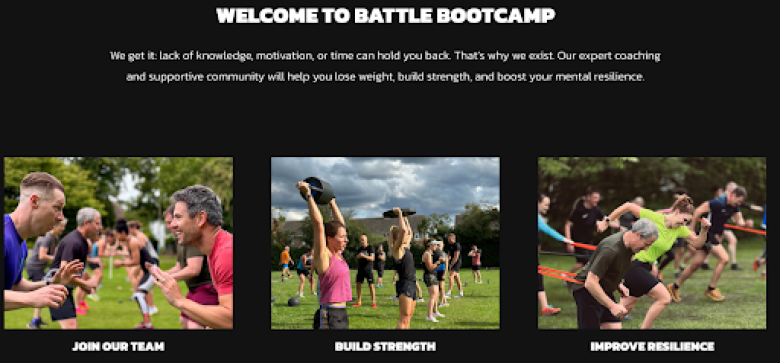
If you’re struggling for a brand name you can always use a brand name AI tool like namelix to generate some names and suggestions for you.
Additionally, you’re going to need to create a company slogan or strapline that resonates with your target audience and encapsulates what your boot camp business is all about.
If you’re struggling to come up with what to include, you can use slogan generator tools like this one by Design Hill to suggest ideas for you.
Create a Logo and Branding Pack
You’re going to need to create a company logo and establish your brand’s identity with colour schemes and messaging style that matches your target audience.
You can hire a graphics designer to do this for you from the likes of people per hour or fiverr.
Alternatively you can utilise a free logo maker like Looka to create your logo for you. See here my fitness boot camp logo that I created using Looka in under 2 minutes:
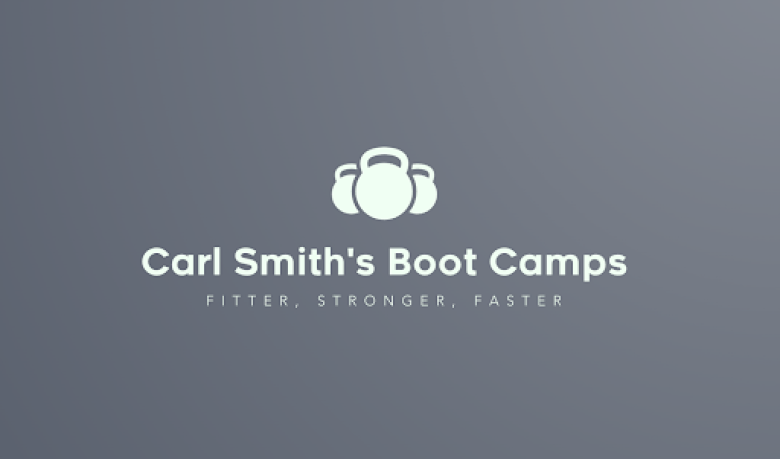
You're going to need to create all your digital assets and branding across all your marketing materials, including; social media, your website, emails, flyers and uniform and to mirror your colour schemes.
Step 10) How to Market Your Fitness Boot Camp Business
When planning how to start a boot camp program or business, you need a pre-defined marketing strategy of how you’re going to get clients and fill your classes.
Here are a few cost effective ways you can market your boot camp business:
Voucher Cloud Websites
You can leverage voucher code websites that have huge number of subscribers like Groupon or Wowcher Cloud to get advertise your boot camp business in front of thousands of people local to you without paying any upfront cost.
See here how Motiv8 is offering 8 weeks of boot camp classes using Groupon:

Find out here how to start marketing your boot camp business with groupon.
Use Class Pass to Grow Your Client Base
Class pass is a software where you can integrate your class timetable into and market your boot camp business to a large database of individuals that are looking for classes in your area.
Over 30,000 private studios, gyms, spas and fitness class based businesses harness Class Pass to help pack out their classes.
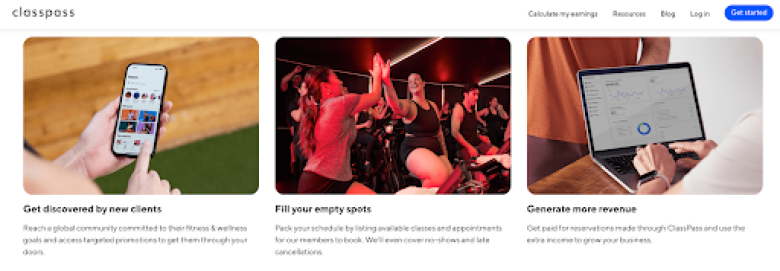
Bring Your Friend For Free System
A good way of generating leads as part of your fitness boot camp marketing plan is to deploy a “bring a friend or buddy class” where once a month you allow your clients to bring a friend or friends to a class.
This is a good way of getting new people to trial your class, makes your existing class members happy to train with one of their friends and you can market and sell your boot camp classes to them later down the line.
See below how Three.Two.Run is using this exact method to attract more people to their fitness classes:
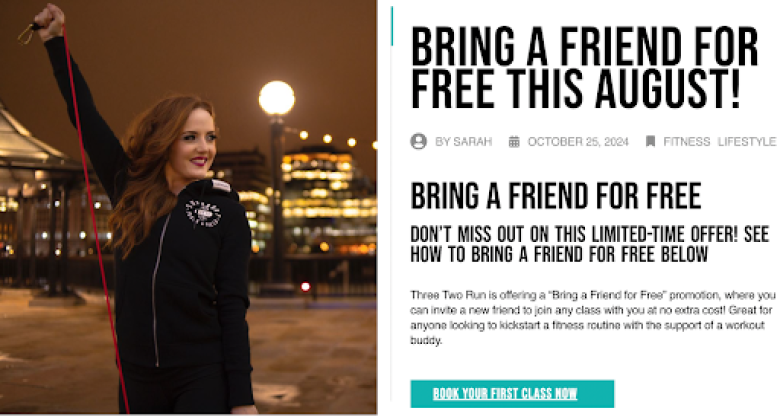
Set-Up an Instagram Business Account
To start a boot camp fitness business one key way to attract clients is through your social media presence.
See here how 1st class boot camp is using their business Instagram account to let followers and potential new followers know when their boot camp classes are running in the New Year:
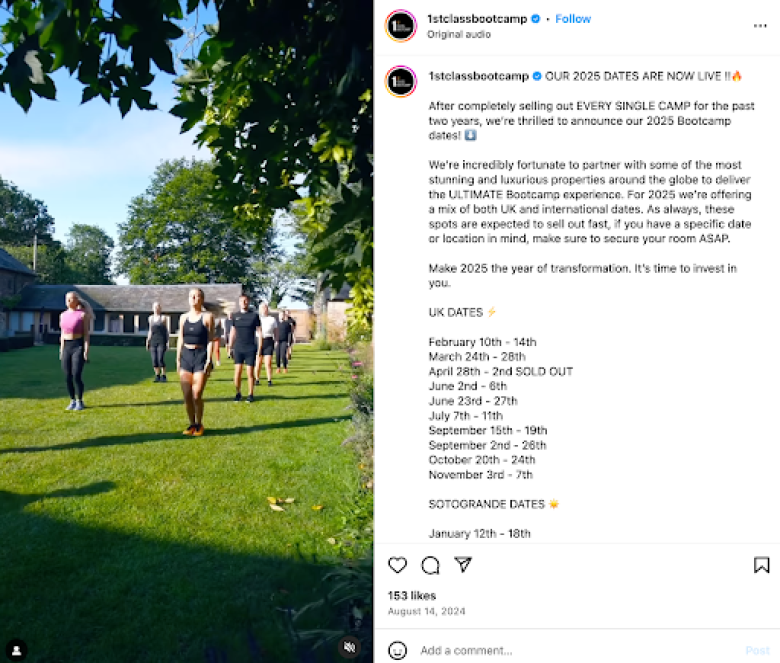
Google Business Profile
Every business should register a Google profile, it's free and extremely effective way of getting Boot camp Clients.
See here when I google “Boot camp classes London” below and you can see Google displaying the top three Boot camp business in London:
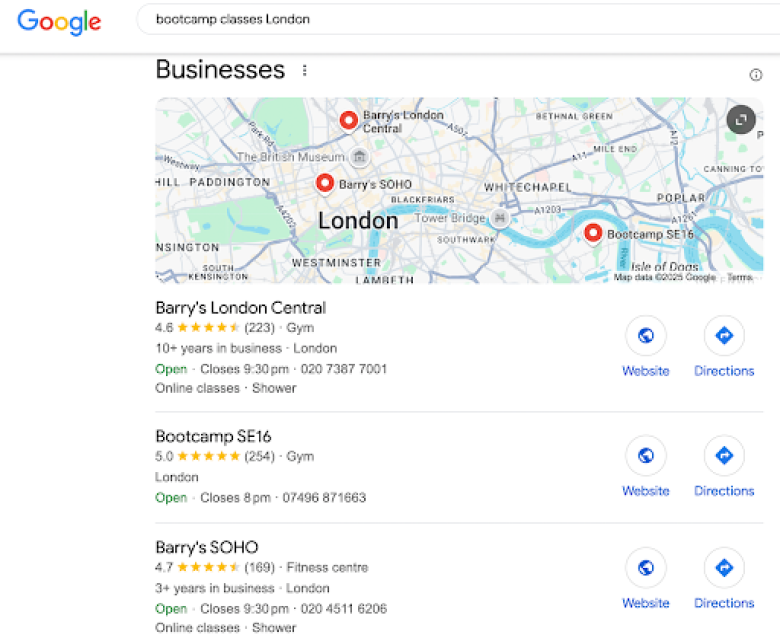
Potential clients can navigate to your website, social media or give you a call.
It only takes 10 minutes or so to set-up your Google my business profile.
Step 11) Plan How to Scale Your Fitness Boot Camp Business
As part of your fitness boot camp business plan, you should plan for longevity and have a strategy for how to scale your boot camp business.
Once you have got your boot camp business off the ground and gained some traction in your local vicinity, there are a few ways you could scale your boot camp business.
Hiring Staff to Deliver Classes For You
If you get to the stage where you have a large number of class members and classes running across the week. It might be time to hire a fitness class instructor to alleviate some of the class delivery and allow you to focus on growing the business further.
You can post fitness instructing jobs and personal training roles for free using our very own jobs board.
Add More Locations
You can start reviewing whether it’s worthwhile adding a new location that opens up a new demographic of clients.
Outdoor Fitness Boot Camp has done exactly that, expanding across the majority of the south of the UK:
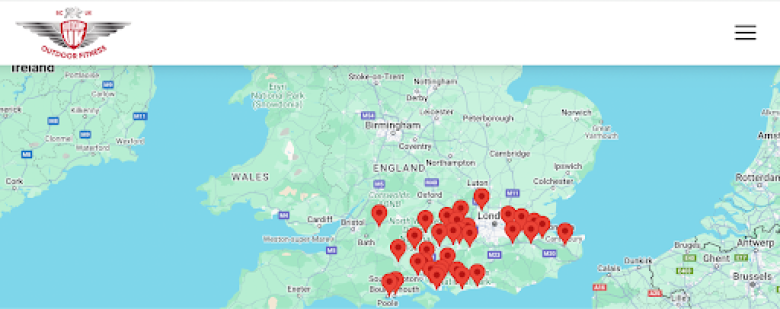
Franchising Your Boot Camp
You could consider franchising your fitness boot camp, where other like minded fitness professionals can buy into your brand and start their own fitness boot camp.
You can charge them a franchise fee, take a small percentage of every membership fee paid as a form of royalty and really scale your business onto new levels.
See below how Rise Boot Camps has scaled their boot camp business to 12 locations by franchising their boot camp model:
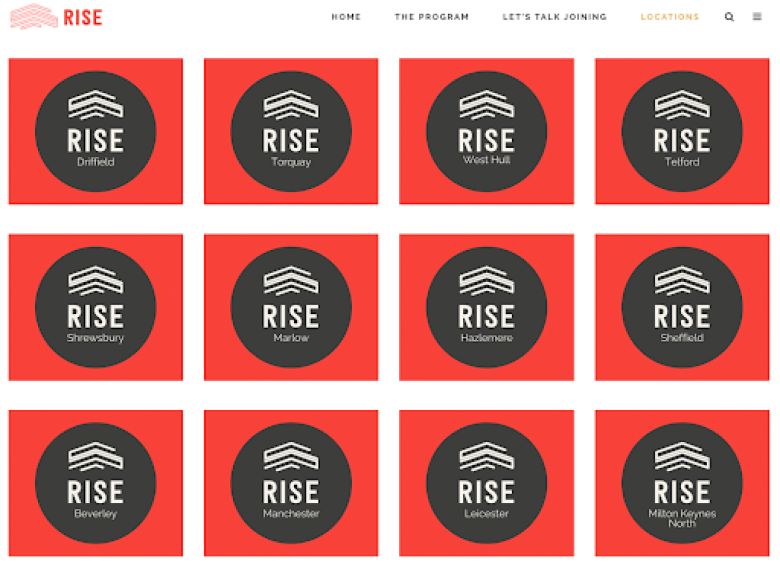
Add Boot Camp Retreats
When you have built up a loyal customer base, you might want to start offering fitness boot camp retreats, where you take clients to different parts of the UK or abroad to have a boot camp focused holiday.
See how GI Jane Boot Camp’s have done exactly this with their military style boot camps in Thailand and Greece:
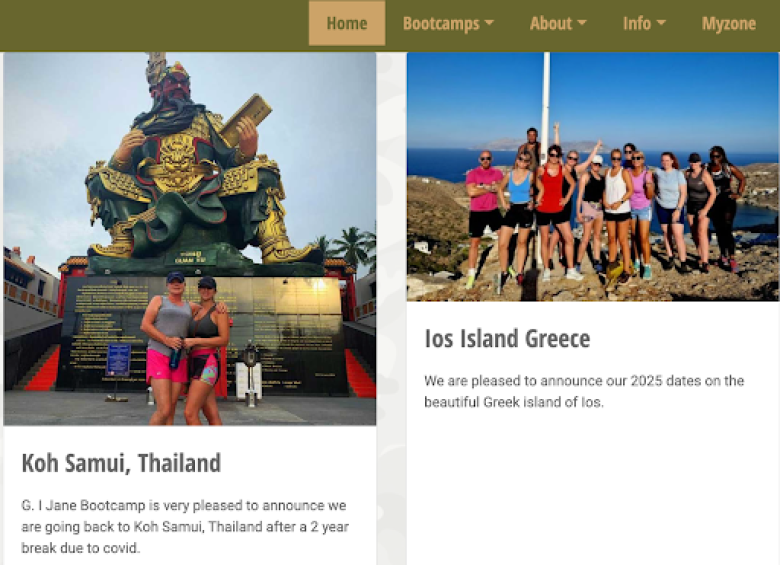
Corporate Team Building Boot Camps
Companies, both small and large are always looking for new ways to increase employee relations, engagement and productivity and one of the ways they do this is through booking team building days or offering their teams activity days.
See here how Motivate Boot Camp has added corporate boot camp classes to their arsenal:

Start an Online Boot Camp Classes
Another avenue to potentially explore is to start an online fitness boot camp where clients can participate in your boot camp from home.
Through an online boot camp you target individuals from all across the UK and internationally, thus vastly widening your demographic reach and giving prospective clients a different route to attending a class.
See below how Forty2 Fitness has done exactly this and offers a virtual boot camp service:
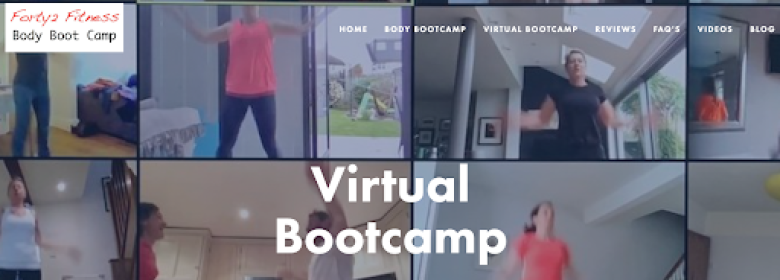
Step 12) Financial Forecasting to Run a Boot Camp Business Successfully: Example
As part of your boot camp business plan you need to orchestrate a financial plan to make sure your company is operating efficiently and most importantly, profitably.
When trying to create a financial projection a good starting point is to focus on your potential expenditure, which consists of both your initial set-up costs and your monthly ongoing costs.
This is echoed by financial expert Steven Kibbel who is a financial planner, entrepreneur, and Chief Editorial Advisor at Gold IRA Companies
"Start by calculating your expenses. It gives you a clear picture of what you need to earn just to break even. Think about your upfront costs, certifications, purchasing equipment, liability insurance. Factor in your ongoing expenses, such as venue rentals, marketing (like social media ads or printed flyers), and continuing education if you plan to stay certified or expand your skills. Don’t forget to estimate how much you’ll spend monthly to keep things running smoothly. It’s better to overestimate expenses than underestimate"
On that note, I have created a 3 year boot camp expenditure plan example, based on if you're starting an indoor boot camp with studio space hire:
Boot Camp Expenditure Example
Initial Costs | Month 1 | Month 2 | Month 3 | Month6 | Month 12 | Month 18 | Month 24 | Month 30 | Month 36 | |
Equipment | £900 | £0 | £0 | £0 | £0 | £100 | £0 | £0 | £0 | £300 |
Space Hire | £0 | £100 | £100 | £150 | £200 | £250 | £250 | £300 | £300 | £350 |
Insurance | £20 | £20 | £20 | £20 | £20 | £20 | £40 | £40 | £40 | £40 |
Professional Licensing | £50 | £50 | £50 | £50 | £50 | £50 | £50 | £50 | £50 | £50 |
Software Subscriptions | £100 | £100 | £100 | £125 | £150 | £150 | £175 | £200 | £200 | £250 |
Website, Hosting and Maintenance | £1,000 | £25 | £25 | £25 | £25 | £25 | £25 | £200 | £25 | £25 |
Marketing | £500 | £200 | £200 | £250 | £300 | £350 | £400 | £400 | £450 | £500 |
Tax / VAT | £0 | £0 | £0 | £0 | £0 | |||||
Professional Development | £0 | £0 | £0 | £0 | £0 | £300 | £0 | £0 | £0 | £400 |
Staff Salaries | £0 | £0 | £0 | £0 | £0 | £0 | £0 | £100 | £150 | £200 |
Travel Costs | £0 | £70 | £70 | £70 | £100 | £120 | £150 | £150 | £180 | £200 |
Legal Fees | £700 | £0 | £0 | £0 | £0 | £200 | £0 | £0 | £0 | £0 |
Branding | £100 | £0 | £0 | £0 | £0 | £100 | £0 | £0 | £0 | £0 |
Music Station / Speakers | £100 | £0 | £0 | £0 | £0 | £0 | £0 | £100 | £0 | £0 |
Laptop / Computer | £500 | £0 | £0 | £0 | £0 | £0 | £0 | £0 | £0 | £0 |
Uniform / Apparel | £150 | £0 | £0 | £0 | £0 | £0 | £300 | £0 | £0 | £0 |
Bank / Payment Charges | £0 | £5 | £10 | £15 | £20 | £25 | £30 | £35 | £40 | £50 |
Misc | £0 | £0 | £0 | £0 | £0 | £0 | £0 | £30 | £0 | £50 |
Total Expenditure | £4,120 | £570 | £575 | £695 | £865 | £1,690 | £1,420 | £1,305 | £1,045 | £2,415 |
Expenditure Considerations when Forecasting for a Boot Camp Business
Notice on the above table how I have forecasted for items that are part of my initial costs, but also allowing some budget for items that might need to be replaced, improved or upgraded later down the line such as branding, website maintenance, legal fees, professional development and equipment.
I have factored these potential costs into my ongoing projections as a piece of equipment might break, I might need to update my terms of services, improve my website or enrol myself onto a course.
See also how I have flexed for potential expenditure increasing over-time with things like marketing costs increasing, space hire, insurance, staff costs and travel.
Lastly, it is a good idea to leave some money aside for tax purposes. Aaron Peak, personal finance expert at CredAbility says:
It’s also important to set aside money for tax. If you earn over £1,000 a year, you’ll need to register as self-employed with HMRC. Keeping business and personal money separate makes it easier to track what you owe, and setting aside 20–30% of earnings stops any nasty surprises at tax time.
Boot Camp Projected Income
Once you have calculated your projected expenditure, you can then adjust your predicted pricing based on the numbers, still factoring your competition and market value to formulate what your income will look like.
Financial Expert Chris says:
After that, move on to forecasting your income. This is where you can start visualising the potential of your business. Start by re-examining your pricing. Be conservative with your estimates, especially in the beginning, as it may take time to build a steady client base.
Here is an example of a projected income report that you can utilise as a guide to opening your boot camp business.
I have created this example based on you adopting the subscription model of selling boot camp classes monthly and offering three packages of one session per week, two sessions per week and three sessions per week, with two sessions per week being potentially the most popular option.
I have also included a sliding scale pricing model, where class attendees pay more per month for more classes, but it works out cheaper per class they attend:
Boot Camp Income Projection Example:
Members on 1 Class per week (£30 p/m) | Members on 2 Classes per week (£50 p/m) | Members on 3 Classes per week (£65 p/m) | Merchandise Sales (£) | Total Members and Gross Income (£) | |
Month 1 | 2 - £60 | 2 - £100 | 0 | 0 | 4 - £160 |
Month 2 | 4 - £120 | 6 - £300 | 1 - £65 | 0 | 11 - £485 |
Month 3 | 7 - £210 | 10 - £500 | 2 - £130 | 0 | 19 - £840 |
Month 6 | 13 - £390 | 20 - £1,000 | 6 - £390 | 0 | 39 - £1,780 |
Month 12 | 20 - £600 | 32 - £1,600 | 11 - £715 | £60 | 63 - £2,975 |
Month 18 | 28 - £840 | 40 - £2,000 | 18 - £1,170 | £100 | 86 - £4,110 |
Month 24 | 36 - £1080 | 49 - £2450 | 25 - £1,625 | £190 | 110 - £5,345 |
Month 30 | 43 - £1290 | 57 - £2850 | 30 - £1950 | £270 | 130 - £6,360 |
Month 36 | 50 - £1500 | 65 - £3250 | 36 - £2340 | £400 | 151 - £7490 |
Income Considerations when Forecasting for a Boot Camp Business
When trying to forecast for growth and income, there are a few considerations you need to think about.
Firstly, you will lose clients and the numbers above should factor in net attrition rates e.g. these are numbers projected including the members you lose on the way.
Additionally, there are times of the year fluctuations to consider such as the January rush in the New Year and the decline in the colder months.
Consider the change in trends, boot camps are still very popular, however this could change, try and factor for this change and have a contingency plan in place, whether that's delving into other class types or supplementing your business with another income stream.
Once you have your projected income and expenditure, you can then do some simple maths and workout your monthly projected profit and loss.
All I have done here is subtracted the total projected expenditure from the total projected income:
Initial Costs | Month 1 | Month 2 | Month 3 | Month6 | Month 12 | Month 18 | Month 24 | Month 30 | Month 36 | |
Profit and Loss | -£4,120 | -£410 | -£90 | £145 | £915 | £1,285 | £2,690 | £4,040 | £5,315 | £5,075 |
As you can see I have flexed for the first 3 months to operate at a loss and then incurring gradual growth over-time as my membership base grows, more classes are added or even new locations.
Step 12) Finalise Pricing of Your Boot Camp Business
Now you have established your business model, what services you're going to provide, conducted some local market research, created an expenditure forecast, only now can you actually finalise your pricing strategy.
Putting prices to packages is one of the last aspects to consider as without the other bits of information first you can't determine what price to charge to make your business operate and function the way you want it to.
Now you can play around with some numbers, make adjustments to your strategy and re-evaluate some of your expected income based on your final numbers.

